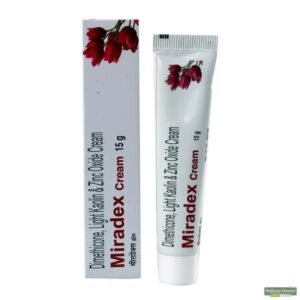DIMETHICONE + ZINC OXIDE + KAOLIN LIGHT
Dimethicone: Dimethicone is a drug commonly used as an active ingredient in various over-the-counter and prescription medications. It is primarily used as an antifoaming agent, emollient, and skin protectant. It is available in topical formulations such as creams, lotions, ointments, and gels, and it may also be found in some oral medications.
Dimethicone works by forming a protective barrier on the skin’s surface. This barrier helps to trap moisture and prevent water loss, thus effectively hydrating and protecting the skin. In addition, it acts as a lubricant, reducing friction and irritation.
The dose of dimethicone varies depending on the specific product and condition being treated. It is important to carefully follow the instructions provided by your healthcare professional or the product’s label.
Side effects of dimethicone are generally rare. However, some individuals may experience skin irritation, itching, or redness after application. If any of these side effects persist or worsen, it is advisable to consult a healthcare professional.
Dimethicone is generally safe for most people to use, but it is always recommended to discuss any new medications or treatments with a healthcare professional to ensure it is appropriate for your specific needs and medical history.
Zinc Oxide: Zinc oxide is a medication and supplement primarily used for the treatment and prevention of various skin conditions. It is available in the form of creams, ointments, powders, and oral supplements.
The main mechanism of action of zinc oxide is its ability to soothe, protect, and promote healing of the skin. It works by forming a barrier on the skin surface, preventing irritants and moisture from coming in direct contact with the affected area. Additionally, zinc oxide has mild antiseptic and astringent properties, which can help reduce inflammation and infection.
Zinc oxide is commonly used to treat a range of skin conditions, including diaper rash, chapped skin, minor burns, and sunburn. It can also be found in some cosmetics, such as foundations and powders, due to its ability to provide a mattifying effect and sun protection. As a supplement, zinc oxide is used to prevent or treat zinc deficiency, which can occur in individuals with certain medical conditions or inadequate dietary intake.
The dose of zinc oxide varies depending on the specific formulation and condition being treated. It is important to carefully read and follow the instructions provided by the manufacturer or healthcare professional. For topical applications, a thin layer of the cream, ointment, or powder should be applied to the affected area and gently rubbed in. For oral supplementation, dosage should be determined by a healthcare professional based on individual needs.
Common side effects of zinc oxide creams or ointments include mild skin irritation, itching, or a rash. These side effects are usually temporary and typically resolve with continued use. In rare cases, individuals may experience an allergic reaction, characterized by severe itching, swelling, or difficulty breathing. If any severe or prolonged side effects occur, medical attention should be sought immediately.
When taken orally as a supplement, zinc oxide can cause gastrointestinal symptoms such as nausea, vomiting, stomach cramps, and diarrhea. High doses or long-term use can lead to copper deficiency and other imbalances in mineral levels. It is important to follow the recommended dosage and consult a healthcare professional before starting any long-term supplementation.
Overall, zinc oxide is generally considered safe when used as directed. However, it is always important to discuss the use of any medication or supplement with a healthcare professional, especially if you have any allergies or pre-existing medical conditions.
Kaolin Light: Kaolin Light is a medication commonly used for the treatment of diarrhea. It is a type of clay mineral that functions as an absorbent substance to help control excessive fluid loss in the gastrointestinal tract.
The mechanism of action of Kaolin Light involves the binding and adsorption of toxins, bacteria, and other irritants in the gut. It forms a protective coating on the intestinal walls, reducing inflammation and helping to firm up the stool.
The recommended dose of Kaolin Light is typically 15-30 grams, taken orally after each loose bowel movement or as directed by a healthcare professional. It is important to follow the instructions provided by the prescribing doctor or mentioned on the packaging.
As with any medication, Kaolin Light may cause some side effects. These can include constipation, stomach discomfort, and nausea. In rare cases, it may also lead to allergic reactions such as itching, rash, or swelling. It is advisable to inform a healthcare professional if any bothersome or severe side effects occur.
It is worth noting that Kaolin Light may reduce the absorption of certain medications if taken simultaneously. Therefore, it is recommended to take other medications at least 1-2 hours before or after using Kaolin Light.
Overall, Kaolin Light is an effective and commonly used drug for the treatment of diarrhea. It helps to control symptoms by absorbing excess fluids and providing a protective coating to the intestines. However, it is always important to consult a healthcare professional for proper guidance and to discuss any concerns or potential drug interactions.

